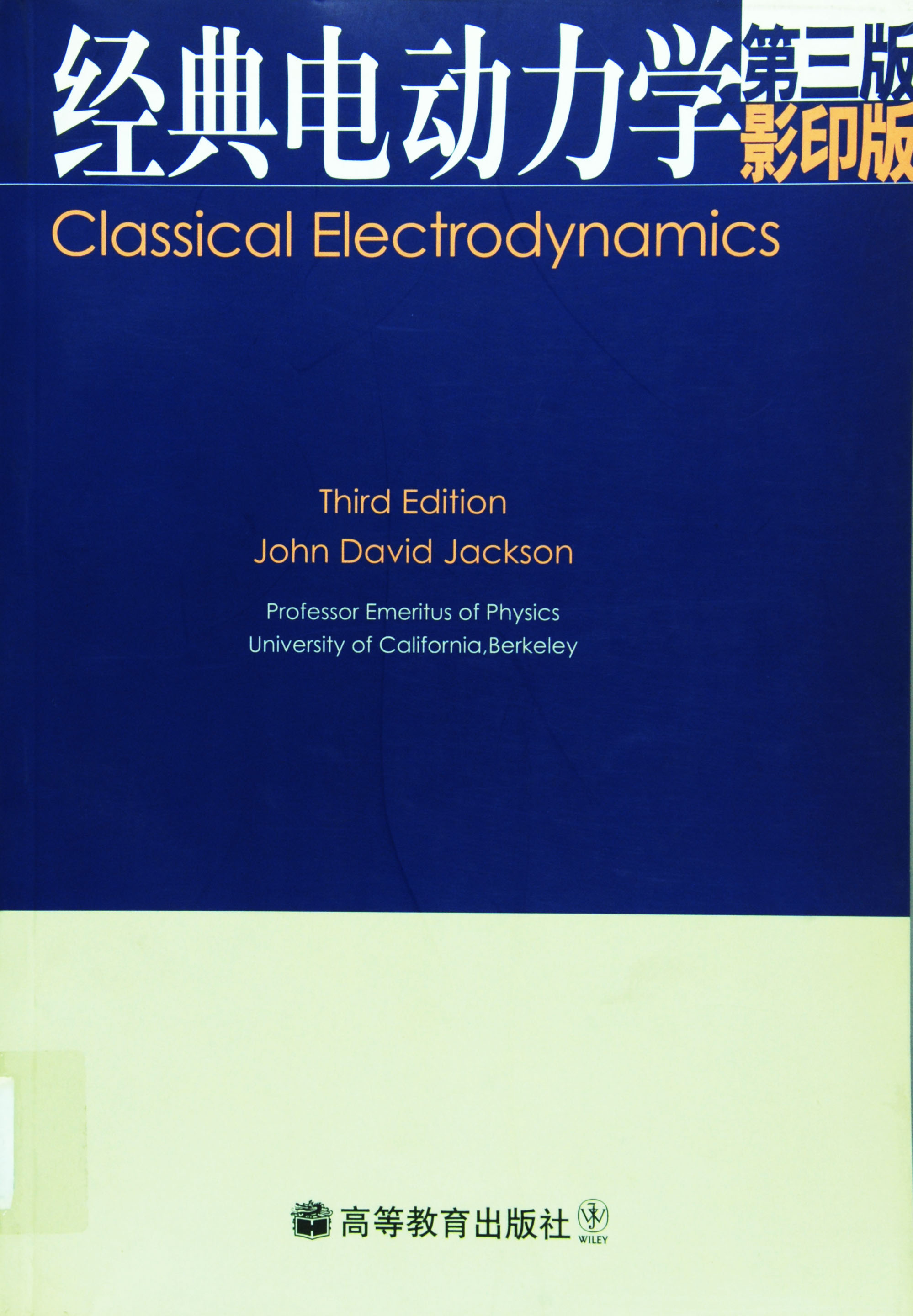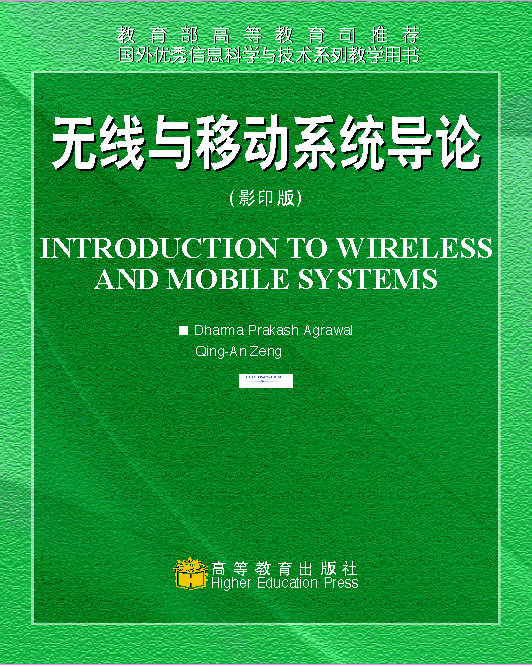经典电动力学(第3版)(影印版)
作者: J.D.Jackson
出版时间:2004-04
出版社:高等教育出版社
- 高等教育出版社
- 9787040144321
- 3版
- 86577
- 48261868-3
- 平装
- 16开
- 2004-04
- 1300
- 810
- 理学
- 物理学类
- O442
- 物理类
- 本科 教育培训
本书是一本有着很高知名度的电动力学教材,长期以来被世界上多所大学选用。本影印版是2001年出版的第三版。与前两版相比,第三版在保留基本经典电动力学内容的基础上,做了不少调整。如增加了一些关于数字计算方面的内容;删除了等离子体一章,将其部分内容在其它章节体现;增加了一些新的科技发展内容,如光纤、半导体波导管、同步辐射等。
全书共分12章,可作为物理类专业电动力学课程的教材,尤其适合开展双语教学的学校,对于有志出国深造的人员也是一本必不可少的参考书。
Introduction and Survey
1.1 Maxwell Equations in Vacuum, Fields, and Sources
1.2 Inverse Square Law, or the Mass of the Photon
1.3 Linear Superposition
1.4 Maxwell Equations in Macroscopic Media
1.5 Boundary Conditions at Interfaces Between Different Media
1.6 Some Remarks on Idealizations m Electromagnetism References and Suggested Reading
Chapter 1 / Introduction to Electrostatics
1.1 Coulomb’s Law
1.2 Electric Field
1.3 Gauss’s Law
1.4 Differential Form of Gauss’s Law
1.5 Another Equation of Electrostatics and the Scalar Potential
1.6 Surface Distributions of Charges and Dipoles and Discontinuities in the Electric Field and Potential
1.7 Poisson and Laplace Equations
1.8 Green’s Theorem
1.9 Uniqueness of the Solution with Dirichlet or Neumann Boundary Conditions
1.10 Formal Solution of Electrostatic Boundary-Value Problem with Green Function
1.11 Electrostatic Potential Energy and Energy Density; Capacitance
1.12 Variational Approach to the Solution of the Laplace and Poisson Equations
1.13 Relaxation Method for Two-Dimensional Electrostatic Problems References and Suggested Reading Problems
Chapter 2 / Boundary-Value Problems in Electrostatics: I
2.1 Method of Images
2.2 Point Charge in the Presence of a Grounded Conducting Sphere
2.3 Point Charge in the Presence of a Charged, Insulated, Conducting Sphere
2.4 Point Charge Near a Conducting Sphere at Fixed Potential
2.5 Conducting Sphere in a Uniform Electric Field by Method of Images
2.6 Green Function for the Sphere; General Solution for the Potential
2.7 Conducting Sphere with Hemispheres at Different Potentials
2.8 Orthogonal Functions and Expansions
2.9 Separation of Variables; Laplace Equation in Rectangular Coordinates
2.10 A Two-Dimensional Potential Problem; Summation of Fourier Series
2.11 Fields and Charge Densities in Two-Dimensional Corners and Along Edges
2.12 Introduction to Finite Element Analysis for Electrostatics References and Suggested Reading Problems
Chapter 3 / Boundary-Value Problems in Electrostatics:Ⅱ
3.1 Laplace Equation in Spherical Coordinates
3.2 Legendre Equation and Legendre Polynomials
3.3 Boundary-Value Problems with Azimuthal Symmetry
3.4 Behavior of Fields in a Conical Hole or Near a Sharp Point
3.5 Associated Legendre Functions and the Spherical Harmonics Ylm(θ, Φ)
3.6 Addition Theorem for Spherical Harmonics
3.7 Laplace Equation in Cylindrical Coordinates; Bessel Functions
3.8 Boundary-Value Problems in Cylindrical Coordinates
3.9 Expansion of Green Functions in Spherical Coordinates
3.10 Solution of Potential Problems with the Spherical Green Function Expansion
3.11 Expansion of Green Functions in Cylindrical Coordinates
3.12 Eigenfunction Expansions for Green Functions
3.13 Mixed Boundary Conditions, Conducting Plane with a Circular Hole References and Suggested Reading Problems
Chapter 4 / Multipoles, Electrostatics of Macroscopic Media,Dielectrics
4.1 Multipole Expansion
4.2 Multipole Expansion of the Energy of a Charge Distribution in an External Field
4.3 Elementary Treatment of Electrostatics with Ponderable Media
4.4 Boundary-Value Problems with Dielectrics
4.5 Molecular Polarizability and Electric Susceptibility
4.6 Models for Electric Polarizability
4.7 Electrostatic Energy in Dielectric Media References and Suggested Reading Problems
Chapter 5 / Magnetostatics, Faraday’s Law, Quasi-Static Fields
5.1 Introduction and Definitions
5.2 Biot and Savart Law
5.3 Differential Equations of Magnetostatics and Ampere’s Law
5.4 Vector Potential
5.5 Vector Potential and Magnetic Induction for a Circular Current Loop
5.6 Magnetic Fields of a Localized Current Distribution, Magnetic Moment
5.7 Force and Torque on and Energy of a Localized Current Distribution in an External Magnetic Induction
5.8 Macroscopic Equations, Boundary Conditions on B and H
5.9 Methods of Solving Boundary-Value Problems in Magnetostatics
5.10 Uniformly Magnetized Sphere
5.11 Magnetized Sphere in an External Field; Permanent Magnets
5.12 Magnetic Shielding, Spherical Shell of Permeable Material in a Uniform Field
5.13 Effect of a Circular Hole in a Perfectly Conducting Plane with an Asymptotically Uniform Tangential Magnetic Field on One Side
5.14 Numerical Methods for Two-Dimensional Magnetic Fields
5.15 Faraday's Law of Induction
5.16 Energy in the Magnetic Field
5.17 Energy and Self-and Mutual Inductances
5.18 Quasi-Static Magnetic Fields in Conductors; Eddy Currents; Magnetic Diffusion References and Suggested Reading Problems
Chapter 6 / Maxwell Equations, Macroscopic Electromagnetism,Conservation Laws
6.1 Maxwell’s Displacement Current; Maxwell Equations
6.2 Vector and Scalar Potentials
6.3 Gauge Transformations, Lorenz Gauge, Coulomb Gauge
6.4 Green Functions for the Wave Equation
6.5 Retarded Solutions for the Fields: Jefimenko’s Generalizations of the Coulomb and Biot-Savart Laws; Heaviside-Feynman Expressions for Fields of Point Charge
6.6 Derivation of the Equations of Macroscopic Electromagnetism
6.7 Poynting’s Theorem and Conservation of Energy and Momentum for a System of Charged Particles and Electromagnetic Fields
6.8 Poynting’s Theorem in Linear Dissipative Media with Losses
6.9 Poynting’s Theorem for Harmonic Fields; Field Definitions of Impedance and Admittance
6.10 Transformation Properties of Electromagnetic Fields and Sources Under Rotations, Spatial Reflections, and Time Reversal
6.11 On the Question of Magnetic Monopoles
6.12 Discussion of the Dirac Quantization Condition
6.13 Polarization Potentials (Hertz Vectors) References and Suggested Reading Problems
Chapter 7 / Plane Electromagnetic Waves and Wave Propagation
7.1 Plane Waves in a Nonconducting Medium
7.2 Linear and Circular Polarization; Stokes Parameters
7.3 Reflection and Refraction of Electromagnetic Waves at a Plane Interface Between Two Dielectrics
7.4 Polarization by Reflection, Total Internal Reflection; Goos-Hanchen Effect
7.5 Frequency Dispersion Characteristics of Dielectrics, Conductors,and Plasmas
7.6 Simplified Model of Propagation in the Ionosphere and Magnetosphere
7.7 Magnetohydrodynamic Waves
7.8 Superposition of Waves in One Dimension; Group Velocity
7.9 Illustration of the Spreading of a Pulse As It Propagates in a Dispersive Medium
7.10 Causality in the Connection Between D and E; Kramers-Kronig Relations
7.11 Arrival of a Signal After Propagation Through a Dispersive Medium References and Suggested Reading Problems
Chapter 8 / Waveguides, Resonant Cavities, and Optical Fibers
8.1 Fields at the Surface of and Within a Conductor
8.2 Cylindrical Cavities and Waveguides
8.3 Waveguides
8.4 Modes in a Rectangular Waveguide
8.5 Energy Flow and Attenuation in Waveguides
8.6 Perturbation of Boundary Conditions
8.7 Resonant Cavities
8.8 Power Losses in a Cavity; Q of a Cavity
8.9 Earth and Ionosphere as a Resonant Cavity:Schumann Resonances
8.10 Multimode Propagation in Optical Fibers
8.11 Modes in Dielectric Waveguides
8.12 Expansion in Normal Modes; Fields Generated by a Localized Source in a Hollow Metallic Guide References and Suggested Reading Problems
Chapter 9 / Radiating Systems, Multipole Fields and Radiation
9.1 Fields and Radiation of a Localized Oscillating Source
9.2 Electric Dipole Fields and Radiation
9.3 Magnetic Dipole and Electric Quadrupole Fields
9.4 Center-Fed Linear Antenna
9.5 Multipole Expansion for Localized Source or Aperture in Waveguide
9.6 Spherical Wave Solutions of the Scalar Wave Equation
9.7 Multipole Expansion of the Electromagnetic Fields
9.8 Properties of Multipole Fields, Energy and Angular Momentum of Multipole Radiation
9.9 Angular Distribution of Multipole Radiation
9.10 Sources of Multipole Radiation; Multipole Moments
9.11 Multipole Radiation in Atoms and Nuclei
9.12 Multipole Radiation from a Linear, Center-Fed Antenna References and Suggested Reading Problems
Chapter 10 / Scattering and Diffraction
10.1 Scattering at Long Wavelengths
10.2 Perturbation Theory of Scattering, Rayleigh’s Explanation of the Blue Sky, Scattering by Gases and Liquids, Attenuation in Optical Fibers
10.3 Spherical Wave Expansion of a Vector Plane Wave
10.4 Scattering of Electromagnetic Waves by a Sphere
10.5 Scalar Diffraction Theory
10.6 Vector Equivalents of the Kirchhoff Integral
10.7 Vectorial Diffraction Theory
10.8 Babinet’s Principle of Complementary Screens
10.9 Diffraction by a Circular Aperture; Remarks on Small Apertures
10.10 Scattering in the Short-Wavelength Limit
10.11 Optical Theorem and Related Matters References and Suggested Reading Problems
Chapter 11 / Special Theory of Relativity
11.1 The Situation Before 1900, Einstein’s Two Postulates
11.2 Some Recent Experiments
11.3 Lorentz Transformations and Basic Kinematic Results of Special Relativity
11.4 Addition of Velocities; 4-Velocity
11.5 Relativistic Momentum and Energy of a Particle
11.6 Mathematical Properties of the Space-Time of Special Relativity
11.7 Matrix Representation of Lorentz Transformations, Infinitesimal Generators
11.8 Thomas Precession
11.9 Invariance of Electric Charge; Covariance of Electrodynamics
11.10 Transformation of Electromagnetic Fields
11.11 Relativistic Equation of Motion for Spin in Uniform or Slowly Varying External Fields
11.12 Note on Notation and Units in Relativistic Kinematics References and Suggested Reading Problems
Chapter 12 / Dynamics of Relativistic Particles and Electromagnetic Fields
12.1 Lagrangian and Hamiltonian for a Relativistic Charged Particle in External Electromagnetic Fields
12.2 Motion in a Uniform, Static Magnetic Field
12.3 Motion in Combined, Uniform, Static Electric and Magnetic Fields
12.4 Particle Drifts in Nonuniform, Static Magnetic Fields
12.5 Adiabatic Invariance of Flux Through Orbit of Particle
12.6 Lowest Order Relativistic Corrections to the Lagrangian for Interacting Charged Particles: The Darwin Lagrangian
12.7 Lagrangian for the Electromagnetic Field
12.8 Proca Lagrangian; Photon Mass Effects
12.9 Effective “Photon”Mass in Superconductivity; London Penetration Depth
12.10 Canonical and Symmetric Stress Tensors; Conservation Laws
12.11 Soiution of the wave Equation in Covariant Form; Invariant Green Functlons References and Suggested Reading Problems
Chapter 13 / Collisions, Energy Loss, and Scattering of Charged Particles,Cherenkov and Transition Radiation
13.1 Energy Transfer in Coulomb Collision Between Heavy Incident Particle and Free Electron; Energy Loss in Hard Collisions
13.2 Energy Loss from Soft Collisions; Total Energy Loss
13.3 Density Effect in Collisional Energy Loss
13.4 Cherenkov Radiation
13.5 Elastic Scattering of Fast Charged Particles by Atoms
13.6 Mean Square Angle of Scattering; Angular Distribution of MultiDle Scattering
13.7 Transition Radiation References and Suggested Readine Problems
Chapter 14 / Radiation by Moving Charges
14.1 Liénard-Wiechert Potentials and Fields for a Point Charge
14.2 Total Power Radiated by an Accelerated Charge: Larmor’s Formula and Its Relativistic Generalization
14.3 Angular Distribution of Radiation Emitted by an Accelerated Charge
14.4 Radiation Emitted by a Charge in Arbitrary, Extremely Relativistic Motion
14.5 Distribution in Frequency and Angle of Energy Radiated by Acceieratea t;narges: Basic Results
14.6 Frequency Spectrum of Radiation Emitted by a Relativistic Charged Particle in Instantaneously Circular Motion
14.7 Undulators and Wigglers for Synchrotron Light Sources
14.8 Thomson Scattering of Radiation References and Suggested Reading Problems
Chapter 15 / Bremsstrahlung, Method of Virtual Quanta,Radiative Beta Processes
15.1 Radiation Emitted During Collisions
15.2 Bremsstrahlung in Coulomb Collisions
15.3 Screening Effects; Relativistic Radiative Energy Loss
15.4 Weizsācker-Williams Method of Virtual Quanta
15.5 Bremsstrahlung as the Scattering of Virtual Quanta
15.6 Radiation Emitted During Beta Decay
15.7 Radiation Emitted During Orbital Electron Capture: Disappearance of Charge and Magnetic Moment References and Suggested Reading Problems
Chapter 16 / Radiation Damping, Classical Models of Charged Particles
16.1 Introductory Considerations
16.2 Radiative Reaction Force from Conservation of Energy
16.3 Abraham-Lorentz Evaluation of the Self-Force
16.4 Relativistic Covariance; Stability and Poincaré Stresses
16.5 Covariant Definitions of Electromagnetic Energy and Momentum
16.6 Covariant Stable Charged Particle
16.7 Level Breadth and Level Shift of a Radiating Oscillator
16.8 Scattering and Absorption of Radiation by an Oscillator References and Suggested Reading Problems
Appendix on Units and Dimensions
1 Units and Dimensions, Basic Units and Derived Units
2 Electromagnetic Units and Equations
3 Various Systems of Electromagnetic Units
4 Conversion of Equations and Amounts Between SI Units and Gaussian Units
Bibliography
Index








